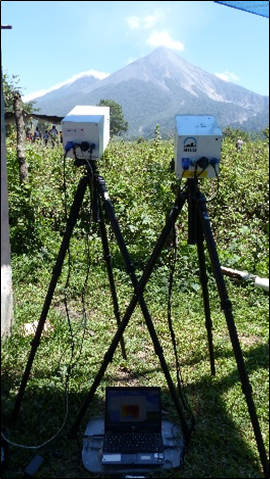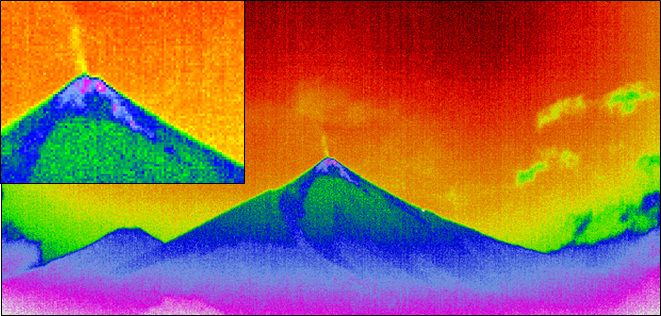Ailsa Naismith, COMET Research Student (Bristol)
Ailsa is a postgraduate student in her first year of study at the University of Bristol. Her work focuses on observing processes and understanding hazards associated with the active Volcán de Fuego in Guatemala.
Fuego is an active stratovolcano in southern Guatemala, located within the Central American Volcanic Arc. Recent ground-based observations of Fuego have revealed a distinctive recurring pattern of behaviour. As part of a fieldwork campaign conducted in early 2017, researchers deployed an array of multi-spectral infrared cameras around Fuego. These cameras captured the growth of an ephemeral summit cone, and built on prior knowledge of the volcano´s activity obtained from infrared data captured in 2016.
A primary goal of studying Fuego is to understand the mechanisms that trigger a paroxysmal event. Acquisition of thermal data and subsequent analyses of time-series will inform understanding of what provokes paroxysm, and lead to improved hazard forecasting. Combining observations from infrared cameras with satellite and visual imagery may provide future advances in understanding.
New observations of Fuego have provided further insight into its changing summit conditions. In 2016, Fuego generated 16 paroxysmal eruptions, set within a recurring cycle of activity: against a background of near-continuous Strombolian activity, the volcano first generates lava flows, before building a transient cone in its summit crater that is eventually destroyed in a paroxysmal eruption which produces pyroclastic flows. The cycle recurred approximately every three weeks.
Analyses of images obtained throughout 2016 have detected well-defined periods of increasing thermal emissions related to lava flow extrusion and paroxysmal summit activity. In February 2017, a research campaign that was directed by Guatemala’s national monitoring institute, INSIVUMEH, and led by a team of volcanologists and engineers from the University of Bristol, deployed an array of multispectral infrared cameras at various locations to measure activity at Fuego’s summit.

Images obtained from the cameras between 19th and 23rd February show an increase in convexity at the summit, presumably representing the growth of a transient cone fed by rising magma. The cone continued to grow during the days preceding a paroxysm that occurred on 25th February. Destruction of an ephemeral cone by a paroxysmal eruption may contribute to ensuing pyroclastic flows.


This work is the beginning of what promises to be an interesting avenue of research. The cameras’ high spatial resolution allows detailed information of the summit to be captured, giving opportunity to better understand regions where there are significant changes prior to eruption.
Capture of a full eruptive cycle – including SO2 and ash emission rates, as well as thermal anomalies and morphology changes at the summit – would greatly inform our understanding of Fuego’s eruptive cycle, and of primary controls on triggering of paroxysm and pyroclastic flow.
